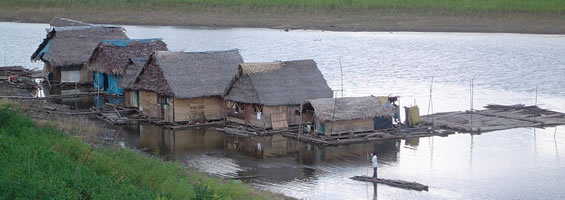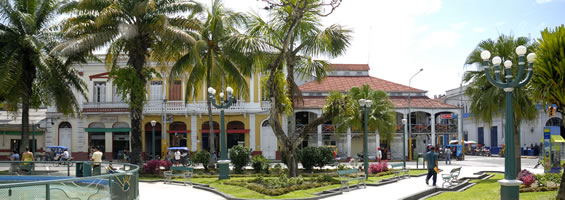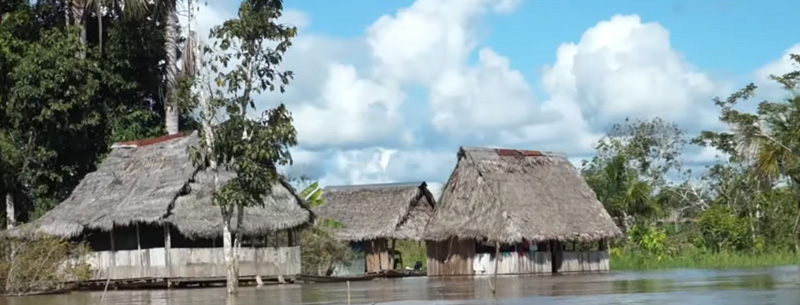Iquitos Peru Travel Guide
Iquitos is the largest city in the rain forest of Peru. It is the capital of the Loreto Region and the Maynas Province.
The city of Iquitos is an ideal place for lovers of ecological tourism, and for the ones who want to feel an intimate contact with the virgin nature of the Amazon forests.

Iquitos is the capital of the Department of Loreto, is also the entrance door to the Amazon. It is framed by the Nanay, Itaya, and Amazon Rivers, which seclude it from any access by land. The only way of communication with the rest of the country is by air or by the river.
The city of Iquitos was a village inhabited by the wild tribe called the “Iquitos” from whom the name was taken in the moment of its foundation in 1864. During the Spanish Colony and the gold fever caused by the legends of “El Dorado” (The Golden) and the “País de la Canela” (Country of the Cinnamon), Iquitos never had historical figuration. In 1883 began in this city the era and peak of the rubber, the exploitation of their latex and trade made that some reached immense fortunes, it brought the prosperity of the city and the construction of splendid houses began, some with tiles brought from Portugal.
Location: North forest, 347 feet above sea level (106 m.a.s.l)
The city of Iquitos
Iquitos is generally considered the largest in the world that cannot be reached by road, only by airplane or boat – unless you’re traveling from Nauta, a small town roughly 100km south. Most travel within the city itself is via bus, motorcycle, or auto.

The Main Square
Heart of the city, congregates many people during the evening, chattering spot. In the center of the square is located a monument in remembrance of the dead warriors of the “Guerra del Pacífico” (Pacific War). In the surrounding areas, you will find the City Hall, the Cathedral, social clubs, and commercial establishments.
Jirón Próspero
It is one of the main streets of the city, most of the businesses are located here, travel agencies, airline agencies, craft markets, banks, cloth stores, and many more.
Belén
It is poor people’s neighborhoods, in the southwest of Iquitos.
Located at 10 blocks from the Main Square. It is located next to the Itaya river and is characterized because a great part of its houses are located on the bed of the river and they are adapted to the changes of the height of the waters.
This neighborhood in turn is the great market of the city, and every day at dawn arrives fishermen, hunters, and farmers with their canoes loaded with products. In the market, you will find medicinal herbs and beverages, exotic and a great variety of fruits.
Casa de Hierro
Built by the French Gustave Eiffel for the Exhibition of Paris in 1889 and bought by millionaire Anselmo del Aguila, the one who brought it in pieces to Iquitos, including bolts and nuts, and assembled it on its actual location, northwest of the Main Square.
Best of Iquitos
The city of Iquitos has several attractions:
San Juan
This is a native community situated south of Iquitos, where there is an important festival in commemoration of Saint John the Patron Saint, on June 24. Habitually Different typical dishes are offered.
Allpahuayo
Mishana Reserved Area: Located on the banks of the Nanay River, in the community of Mishana, in an area of approx 57,667. Established in 1999, to preserve eco-systems that are unique to the Peruvian Amazon Region. It’s easy to reach this area, as it is near the Iquitos – Nauta road and ideal for scientific research on the essential ecological processes of the tropical rain forest.
Santa Clara
Located on the banks of the Nanay River, 12 km from Iquitos. Its main attractions are its white sandy beaches, formed when the river ebbs, and its great beautiful landscape.
Pacaya Samiria National Reserve
Located in the area where the Ucayali and Marañon Rivers converge, this is the country’s largest reserve, with 2,080,000 ha. and the fourth in South America. It was established in 1982, to preserve the abundant and varied wildlife. It’s countless lakes, swamps and aguajales serve as shelter to 132 species of mammals, mainly rodents and monkeys; 330 species of birds; approximately 220 species of fish, main source of protein for the inhabitants of the Region, and approximately 150 species of reptiles and amphibious animals. The Reserve can only be reached by river and it takes al least one week to visit it, including three days to access and exit the area.
Iquitos History
Iquitos was established as a Jesuit mission in 1750 and in 1864 it started to grow when the Loreto Region was created and Iquitos became its capital.
Iquitos was known for its rubber industry through the first decade of the 20th century, and there are still great mansions from 1800, including the Iron House (Spanish: Casa de Fierro), designed by Gustave Eiffel.
The boom came to an end when rubber seeds were smuggled out of the country and planted elsewhere. The 1982 movie Fitzcarraldo, about the life of rubber baron Brian Sweeney Fitzgerald, was filmed around Iquitos
The city of Iquitos began in 1739 when Jesuit Jose Bahamonde established settlements at Santa Barbara de Nanay and Santa Maria de Iquitos on the Rio Mazan.
It was a particularly daunting task, as the missionaries here faced the task of converting the fierce Iquito Indians, renowned as marksmen with their long poison-dart blowpipes.
There are only one or two families of the Iquito tribe left, living way on the upper Rio Nanay, and these days the region is better known for the Yaguar, Bora, and Witoto tribes, whose handicraft can be seen virtually everywhere you turn in the modern city.
Folklore in Iquitos
In the environs, several places exist in which part of the folklore and the local culture can be appreciated.
The Cajada
It’s danced in veiled of the saints, has a smooth rate and his melodias is somewhat melancholic. The Chimaychi: He is owner of the celebrations of natalicios in the small villages and riberenos towns, the steps are very similar to those of huayno of the mountain range.
The Changanacuy
The Pair is crossed Mutually of legs, is danced single at the time of “Easing up”, This typical dance of the Amazonian forest is most popular and cheers, which is made around humisha in supervisory celebrations like San Juan and carnivals.
El Sitaracuy
In Quechua, it means ant that bites, is danced giving small jumps to the compass of music as if on the feet of the pair there was a nest of ants you see it is possible to be tweaked to him to the pair like the ant puncture.
Getting to Iquitos
The city of Iquitos is only connected by air and water with the rest of the world and is indeed the largest town on the Amazon without road connections.
Land: Not recommended. However, once in Iquitos, there are trucks, buses, and taxis, plus motorcyle taxis called motocarros. You’ll find them at stands around the Plaza 28 de Julio.
Air: Iquitos is served by direct flights from Lima and other major cities in Peru. Iquitos also receives international flights from Miami. But most visitors prefer to fly into Lima on any of the international airlines, and then take a connecting flight to Iquitos. Iquitos Airport has located 8 km from the city.
There are twice-daily flights to Lima for USD 59 and also flights to Caballococha for USD 40.
Boat: There are several boats upstream to Pucallpa every two days or less, depending on the season, for around USD 25, taking between 3 and 7 days. The city of Iquitos is well connected by water to several destinations across the Amazon. Water taxis and boats line up along the shores of the Amazon River. Boats operate from several destinations in Peru, Colombia, and Brasil to Puerto Masua, a short distance north of Iquitos.
